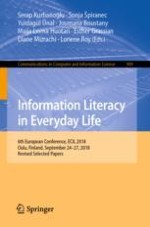2019 | OriginalPaper | Chapter
Biographical Space, Digital Death and Information Literacy Skills: Current Issues
Authors : Paula Ochôa, Leonor Gaspar Pinto
Published in: Information Literacy in Everyday Life
Publisher: Springer International Publishing
Activate our intelligent search to find suitable subject content or patents.
Select sections of text to find matching patents with Artificial Intelligence. powered by
Select sections of text to find additional relevant content using AI-assisted search. powered by
